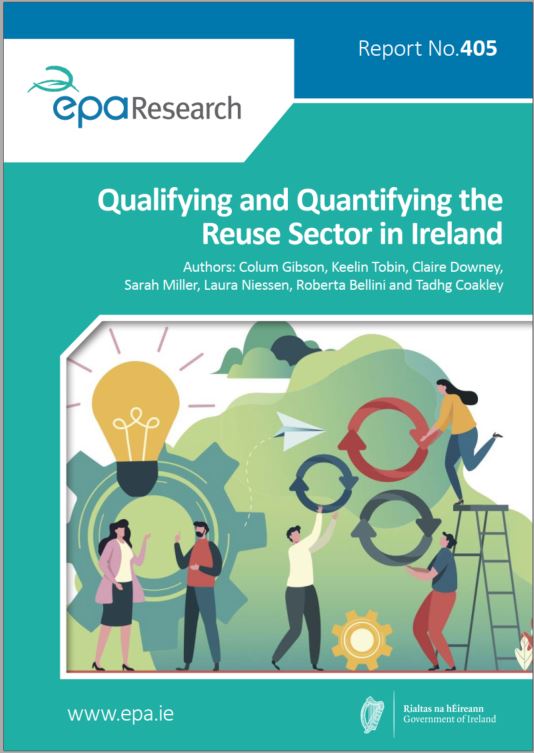Research 405: Qualifying and Quantifying the Reuse Sector in Ireland
Authors: Colum Gibson, Keelin Tobin, Claire Downey, Sarah Miller, Laura Niessen, Roberta Bellini and Tadhg Coakley
Summary: Recent EU legislation aims to strengthen reuse in all Member States and asks Member States to measure reuse, with the option of setting national targets in the future. By gathering information on the scale and size of the reuse sector in Ireland, we can benchmark and compare our reuse sector against others. This study assessed the capability of the Irish reuse sector to supply the data necessary for quantifying the extent of reuse in Ireland and informing Irish policymakers on the steps required to support the sector to report in the future.

Project Highlights
Watch the project highlights video
Recent EU legislation aims to strengthen reuse in all Member States and asks Member States to measure reuse, with the option of setting national targets in the future. By gathering information on the scale and size of the reuse sector in Ireland, we can benchmark and compare our reuse sector against others. This will allow the sector to be improved for all (practitioners, users, volunteers, etc.) and will also provide a picture of the scale of reuse, which can be compared with overall material flows, consumption rates, waste arisings and rates of recovery and recycling.
Identifying Pressures
The current take, make and dispose economic model cannot be sustained. It is estimated that 40% of all greenhouse gas emissions are associated with the extraction and production of goods. By keeping these goods in the economy for longer than at present, through reuse, we can reduce the pressure on upstream activities and move towards a circular economy while also addressing climate breakdown. There are also significant social and economic benefits to reuse, including creating jobs, stimulating business development and growth, and providing training opportunities.
However, the reuse sector in Ireland is currently far from mainstream. The sector has evolved organically and is largely made up of small and medium-sized enterprises, most of which are not-for-profit organisations. They are involved in reuse for a wide range of reasons, with resource conservation often low among their priorities. These operators tend to have limited capacity and resources, operating on very tight margins. Ensuring that these operators can contribute effectively to national policies and reuse targets requires a detailed level of understanding of the reuse sector so that it can be supported to address our national reuse commitments.
Informing Policy
The current take, make and dispose economic model cannot be sustained. It is estimated that 40% of all greenhouse gas emissions are associated with the extraction and production of goods. By keeping these goods in the economy for longer than at present, through reuse, we can reduce the pressure on upstream activities and move towards a circular economy while also addressing climate breakdown. There are also significant social and economic benefits to reuse, including creating jobs, stimulating business development and growth, and providing training opportunities.
However, the reuse sector in Ireland is currently far from mainstream. The sector has evolved organically and is largely made up of small and medium-sized enterprises, most of which are not-for-profit organisations. They are involved in reuse for a wide range of reasons, with resource conservation often low among their priorities. These operators tend to have limited capacity and resources, operating on very tight margins. Ensuring that these operators can contribute effectively to national policies and reuse targets requires a detailed level of understanding of the reuse sector so that it can be supported to address our national reuse commitments.
Developing Solutions
This study assessed the capability of the Irish reuse sector to supply the data necessary for quantifying the extent of reuse in Ireland and informing Irish policymakers on the steps required to support the sector to report in the future. This included researching and mapping a database of over 1200 reuse practitioners, sampling and surveying practitioners to obtain targeted qualitative and quantitative data, identifying challenges associated with data collection and reporting, and developing a suitable calculation methodology.
Based on this, the proposed national methodology developed involves obtaining unit data from a representative sample of reuse operators from specific reuse activity areas, converting these to weights using product weight values (based on a fixed set of material subcategories) and scaling up to a national reuse figure by multiplying the average weights estimated by the total number of points of exchange per reuse operator type/product category.
This proposed methodology provides a solution for the measurement of reuse that is anticipated within the Waste Action Plan for a Circular Economy and which will be enabled through the circular economy bill and underpinned by the national circular economy strategy.
https://www.epa.ie/media/epa-2020/research/epa-funded-research/Report-cover-405.jpg